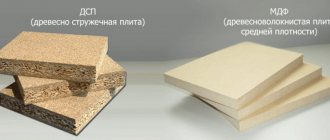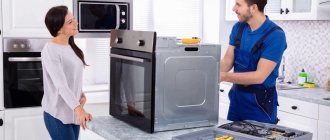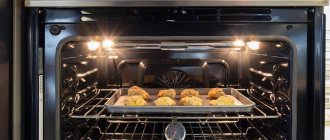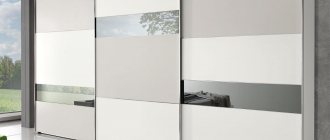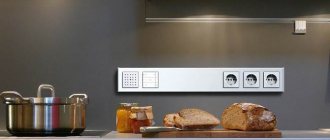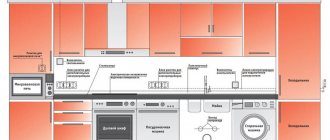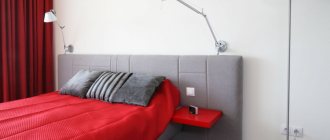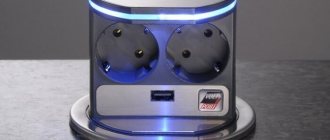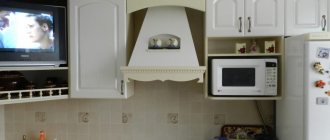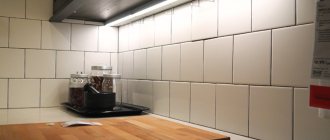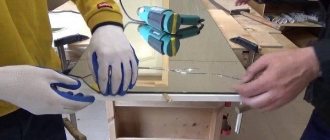The socket for the hob and oven must meet all safety requirements and must be installed following all installation rules. Such household appliances are now in great demand in any kitchen; you will learn how to connect them to the mains later in this article.
You need to take the choice of electrical installation devices and wiring seriously, because now any equipment “eats” a lot of electricity and the issue of saving should be one of the first places. To do this, you need to select separate lines with a special design for sockets.
Next, we’ll find out how to connect the socket for the oven and hob with your own hands.
Is it possible to place the oven against the wall?
It is not recommended to place the oven, like the hob, close to the refrigerator - this can negatively affect the operation of both appliances. It is also impossible to install equipment close to the wall - it is advisable to leave 5–10 cm.
Interesting materials:
Where is the best place to store contacts? Where is the best place to store onions and garlic? Where is the best place to relax at sea with children? Where is the best place to relax in August? Where is the best place to relax in November? Where is the best place to relax in Egypt in winter? Where is the best place to put a child's bed? Where is the best place to spend Christmas in Europe? Where is the best place to spend Christmas? Where is the best place to study to become an interior designer?
Connecting an induction hob
Let's look at the connection using an Electrolux induction hob as an example. Such a panel has high power; it is plugged not into a regular household outlet, but into a power outlet designed for a current of more than 16 A.
The power socket for connecting the induction cooker is selected according to its load. The total load of an induction cooker can be on average 25-32 A, depending on the number and power of burners.
To power the induction cooker, in this case, an individual electrical wiring line must be laid. The cable cross-section depends on the load of the induction cooker: for a current of 25 A, a copper cable with a cross-section of 4 square meters should be laid. mm, for a load of 32 A - 6 sq. mm.
For safe operation of the induction cooker, the electrical wiring must have a working protective ground. That is, for a single-phase network, a three-core cable must be connected to connect the induction cooker. Accordingly, the purchased power socket and plug set must also have a third grounding contact.
If it is not possible to purchase a power outlet of the required power, then as an alternative, you can connect the induction hob to the terminal block installed in the installation box. The terminal block must be able to withstand the rated current of the induction cooker connected to it.
As for the cable through which the induction cooker is connected, in this case it all depends on the configuration. If the power cable is included, then it is enough to connect it to the terminal block directly on the induction cooker, and then to the purchased power plug or in the terminal block, depending on the chosen method of connecting the induction cooker.
If the cable is not included, it must be purchased separately. When purchasing a cable, you must pay attention to its cross-section - it must correspond to the load being connected. It is necessary to purchase a flexible three-core cable with a cross-section of 4 or 6 square meters. mm for rated currents of 25 and 32 A, respectively.
To avoid errors, it is recommended to connect the cable to the stove itself, as well as to the plug, according to generally accepted color markings: brown or black - phase conductor, blue - neutral conductor, yellow-green - protective grounding conductor.
- If the cable is already connected to the terminal block of the electric stove, then you need to check that it is connected correctly. The following terminal markings are usually indicated on the terminals of an induction cooker:
- L - phase output or L1, L2 (L3) - phase outputs for two-phase (three-phase) connection;
- N - zero output;
- PE is the connection point for the protective grounding conductor.
Two-phase and three-phase connection of an induction cooker
Certain types of induction hobs may provide a two or three-phase connection to the electrical network. If the house has a three-phase input, then such an electric stove is connected as recommended by the manufacturer - to two or three phases of the electrical wiring with a four or five-core cable.
The electric stove is connected to a single-phase household electrical network with a three-core cable, and special jumpers between the phases, which are usually included, are installed in the terminal block on the induction cooker. If there are no jumpers, then the connection to two or three phase terminals is made with a wire of a cross-section corresponding to the load of the electric stove.
It should be taken into account that if the kit includes a cable for two- or three-phase connection, then it is not designed for single-phase connection, since when the induction cooker is connected single-phase, the load on the phase conductor increases to the total load of all phases.
Therefore, when using a four (five) core cable to connect to a single-phase network, two (three) phases on the plate are connected to the cable cores, and at the other end of the cable, when connected to a plug or terminal block, the phase conductors are short-circuited with each other and connected to one phase of the electrical network .
Or a new three-core cable is purchased, which has sufficient load capacity for a single-phase connection of an electric stove.
Hob electrical power kW
- The power of the hob is an important parameter when choosing a device for three main reasons:
- The speed with which your dishes undergo heat treatment depends on the power. Agree that it is better when it is possible to prepare dishes as quickly as possible.
- Modern stoves have burners of different power, and this is very convenient. If you only need a small amount of heat, why waste extra gas or electricity on uselessly heating the air in the kitchen. However, the other side of the issue should also be taken into account - the power of the largest burner should also be sufficient to quickly cook a large pot of soup.
- Modern kitchens often have air conditioning installed. When heat energy is released in too large quantities, the load on the air conditioner increases accordingly. At the same time, the extra costs for both heating the air and cooling it are completely unjustified.
So, it is worth choosing a hob with such power that the cooking time is fast, but the heat generated is optimal.
An electrical device of a traditional design consumes the most electrical power of all the types considered, so we will start the review with this option.
- The most common stoves on the market these days are those with four burners. Thus, the standard number of heating points has not changed over the decades of the existence of home stoves. The connection is also similar. However, manufacturers have gone to modernize the heating points, so they have different power:
- the first burner has the lowest power - 0.4-1 kW;
- two burners have an average power of approximately 1.5 kW;
- The fourth burner has the highest power - up to 3 kW.
An induction hob is the most modern type of equipment for heating food in the kitchen. Its average power is about 7 kW. However, please note that this is the consolidated power of the device.
Due to the fact that cooking on an induction surface takes a minimum of time, the simultaneous operation of all disks is almost impossible. And even if this happens, the short period of peak energy consumption is quickly replaced by inaction, since the cooking has already ended - the soup has finished cooking, the fish has finished cooking, the kettle has boiled.
Thus, although the power of an induction cooker is equal to the power of a conventional electric cooker, by heating exclusively the bottom and lower part of the cookware (and not the air underneath), electricity is spent only on heat treatment of the products. It is important to note that saving energy requires the use of special cookware in cooking.
Working surface
How to properly remove power, and where is the best place to do it for small household appliances? Finding the answer to this question is a serious challenge for many.
Here it is necessary to take into account the possibility of simultaneously connecting the necessary kitchen appliances. For example, it is quite possible that you will need to turn on a kettle, toaster, coffee machine and mixer in one zone, so it is advisable to remove the block of 4 sockets in the appropriate place.
Naturally, it is impossible to provide for everything, so it is recommended to additionally provide for a reserve.
As practice shows, there are never too many sockets. It is considered normal to place blocks at 3–4 points at intervals of 1000–1200 mm along the entire length of the work area table top.
Please note that, for safety reasons, it is prohibited to install sockets closer than 500 mm from the gas pipe riser and wet areas, including the sink mixer.
In relation to the tabletop, electrical fittings should be placed at a height of at least 100–150 mm, which is 900–950 mm from the floor level. The final dimensions are determined taking into account the selected tile - so that the blocks fall on its center. If the electrical installation has begun, but there are no tiles, it is enough to simply separate the wires with a reserve, and install the socket boxes closer to the start of the tiling work.
How to connect the fishing line to the electrical panel?
When the oven is connected to the electrical panel, it is recommended to allocate a separate mowing line for it, which is protected by an automatic switch:
- If the rated current of the device is 16A, a 25A circuit breaker is installed.
- If - 32A, the switch must be taken at 40A.
READ Can an iron bowl be placed in the microwave?
Important! A protective ground connection is required. The oven power cable has one grounding conductor connected to the appliance body. It is brought out in order to connect to the corresponding contact on the electrical plug. The insulation color of such a core is yellow-green.
Sometimes the insulation of the lead-out wires may be the same color or the markings may not be the same as usual.
Important! If you make the connection yourself, you must make sure that all pins are connected correctly.
In order to detect the phase conductor, you can use an ordinary indicator screwdriver. But in order not to confuse the ground and neutral wires, you will have to use a tester.
To determine the phase, neutral and ground wires, you can use the following algorithm:
- Using an indicator screwdriver, in the place where the electrical outlet will be installed, you should determine the phase wire. It must be marked with electrical tape or signed.
- To determine the neutral wire on the electrical panel, an indicator screwdriver is also used.
- To detect the grounding conductor, you need to carefully inspect the metal body of the shield or a special block. Usually he connects to them.
- Next, the phase and neutral wires from the input circuit breaker are disconnected. Then they need to be connected to each other.
- On the device side, you need to check the resistance using a tester, which is formed between the phase wire and the remaining two. When the resistance value is minimal, this indicates that the neutral wire has been detected.
- After identifying and labeling all the wires, you can install the socket and connect the cable to the circuit breaker.
Where to begin?
The final decision on the choice of installation location for sockets should be made only after determining the configuration of the kitchen set. It is necessary to take into account all cases, shelves, drawers, type of hood, etc. All this is done in order to place the outlet in the most convenient place from the point of view of operation.
To begin with, think about what kind of apron you will have in the kitchen - for example, panel or tile? This determines whether there will be a need to install mounting boxes.
If the furniture is made to order, you will probably have a diagram of the future set on hand, which will significantly simplify the further design process.
If you are using an old headset, you will need to make a small sketch and enter the actual dimensions into it.
Once you have the diagram in hand, you can proceed to calculating the required number of sockets.
Often a separate point is designed for a hob, oven, refrigerator, microwave oven and hood. Optionally, additional blocks are installed for a mixer, electric kettle, blender, etc.
Advice! It is quite acceptable to use a universal scheme that can be found on the Internet. The only thing that is required is to make minor adjustments regarding the connection to stationary electrical devices.
Hob and oven
Even at the stage of rough work, the wiring diagram must be correctly drawn up, and all the nuances of consumer power must be taken into account.
Typically, the hob and oven are connected separately. This is due to the technical characteristics of each device. A wire with a cross-section of 6 squares is usually installed under the hob. It is designed for loads up to 6–7 kW, and often no socket or junction box is installed.
The oven can easily get by with a stationary 16A household socket. It can withstand up to 3.5 kW load and is powered by a 2.5 square wire.
If the oven is installed under the panel, the sockets are installed at a height of 150–180 mm from the floor surface, next to each other. This is explained by the fact that at this level there is usually a drawer “for frying pans” and other utensils, by removing which you can provide access to the network and cables.
Often, socket blocks are placed behind an adjacent housing, 150–250 mm from it. Recommended height for their placement: within 200–800 mm from the floor.
When an oven is supposed to be built into a column, it is necessary to design a corresponding outlet for it at chest level. It is allowed to install the socket block 150–250 mm above or below the oven. Then the power supply to the plate can be located at a height of 650–800 mm due to the absence of the need to maintain the connection points.
When it comes to a free-standing electric stove, it is advisable to place the outlet on the left or right side, behind the adjacent housing. The height of its location can vary from 150 to 800 mm.
Fridge
Taking into account the short length of the cord for a built-in refrigerator and the manufacturers' recommendations, it is obvious that the outlet should be somewhere nearby. The use of extension cords and temporary carriers is not permitted.
For obvious reasons, it is advisable to choose the location of the power supply on the side of the household device. Ideally, it should be behind the adjacent cabinet, at a height of 150–800 mm from the floor and no more than 250 mm from the refrigerator itself.
Connection of a free-standing refrigerator is possible behind its rear wall. Ideally, there should be a distance of no more than 100 mm from the edge of the socket to ensure free access to it.
Attention! Some models of refrigeration units are manufactured with separate power supply to the main compartment and freezer compartment. In this case, you should add another outlet. Usually a wire of 2.5 squares and 16A fittings intended for equipment up to 3.5 kW of power are laid under it.
Washing machine and dishwasher
Usually the “dishwasher” is placed not far from the kitchen sink - accordingly, the socket for this appliance should be made in one of the adjacent lower cabinets.
Electricity is discharged at a height of 150–500 mm from the floor and at a distance of 150–200 mm from the adjacent kitchen building.
The mistake is to install the outlet directly behind the dishwasher. This is fraught with the fact that the built-in equipment will subsequently not be able to fit in depth into the niche intended for it.
Important! The socket must be installed at least 500 mm from the water supply.
Microwave
It is normal to install the microwave oven at eye level of the user. Regarding the built-in device, it is better to install the corresponding socket below the cabinet where the microwave will be installed, at a height of 150–800 mm from the floor.
If you plan to permanently install the stove on a countertop, there should be a 16A socket nearby, up to 3.5 kW, with a 2.5 square meter wire.
Hood
Based on the type and model of the hood that you plan to use, a separate electrical outlet is selected or a mounting box is installed for the fittings.
Most devices are covered by kitchen cabinets, so the outlet can be placed inside them, on the left or right side of the ventilation duct. This is usually a height of about 1700–1900 mm from the floor. It is allowed to install a socket above the cabinets - 2400–2600 mm.
Open hoods are often connected directly, so the power wires can be terminated even behind the ventilation pipe. It should be noted that manufacturers of household appliances stipulate this point in the relevant instructions.
Regardless of the chosen hood, for its operation it is enough to supply a 2.5 square wire and, if necessary, install a regular 16A, 3.5 kW socket.
Sockets and furniture. How not to hide an outlet behind a closet
Furniture is the last thing that needs to be purchased and installed in the apartment, but electrical wiring must be done before plastering the walls and wallpapering, finishing the ceiling and laying the flooring.
The height of the furniture outlet must be calculated from the level of the finished floor, that is, from the floor covering.
Location of sockets in the kitchen from a clean floor Location of sockets in the kitchen from a clean floor
How to calculate correctly, especially in cases where the furniture has not yet been purchased?
Of course, the most ideal option is to purchase furniture and store it somewhere else until all construction work is completed.
But this option is not always possible, so furniture is selected and purchased at the last moment, and sometimes customers change furniture on their own initiative in an already agreed upon design project.
If the furniture changes, you may have to change the location of the sockets.
For convenience, we have collected the most versatile and popular heights.
- The height of the sockets in the kitchen between the lower and upper cabinets is 1200mm from the finished floor.
The height of the lower cabinets is 820-930mm, the lower edge of the upper cabinets and shelves is 1300-1500mm
Possible mistakes
Sometimes craftsmen make the following mistakes when installing sockets under the oven:
- Lay a separate wire, grounding the power point to pipes and risers. This is life-threatening.
- Connect other household kitchen appliances to the oven's power circuit. This provokes emergency situations.
- Three-phase models of equipment are connected to a single-phase electrical line. Some of the hob burners will be blocked, and their indicators will show residual heat.
To choose the right socket for your oven, you must first read the technical documentation for it. You cannot use a double combination socket to connect a hob and oven at the same time. A separate powerful cable is pulled for each type of equipment. If both types of equipment are on the same supply line, this will trigger the machine.
In new buildings, the issue of connecting power lines to kitchen electrics is already provided for. Therefore, here it is easier for the master to connect with his own hands.
Carrying out installation work
The main thing when performing electrical installation work is compliance with safety rules. Always operate with the power switched off.
Connecting the plug and socket
To connect the plug, strip the wire from the oven or stove; if the wire is stranded, then crimp it with NShV lugs and pass it through the plug body. Mount the phase and neutral on the outermost contacts of the plug. Yellow-green grounding conductor - on the middle contact. To prevent the wire from dangling inside the plug, clamp it with a clamp and tighten the plug body.
The socket is connected in the following way: the socket is mounted in the required place, the socket body is removed and the power line is connected to it. Mount the phase and neutral on the outermost contacts of the socket. Yellow-green grounding conductor - on the middle contact. Next, screw the socket housing.
Cable connection diagrams for the oven and hob
There are two main circuits for connecting an electric stove or hob: single-phase and three-phase. The connection is made to the terminals of the hob, which can be accessed through its back cover - it is unscrewed and removed. Pay close attention to the color markings on the terminals - this will allow you to avoid mistakes, read the connection instructions and safety requirements.
Single-phase 220V circuit (most common in apartments)
Phase L is simultaneously connected to terminals L1-3 of the hob. To do this, two removable copper jumpers are installed between them at the manufacturer. If for some reason you don’t have jumpers, you can make them yourself from an electrical cable whose cross-section is no less than that of the supply cable. Zero N is connected to terminals N1-2. Protective conductor PE – to the PE terminal.
Three-phase 380V circuit (common in private homes and businesses)
Phases A, B, C – are connected to terminals L1-3 of the hob. In this case, it is necessary to remove the jumpers installed at the factory between terminals L1-3. Zero N is connected to terminals N1-2. Protective conductor PE – to the PE terminal.
Connecting the oven is much easier. Most often, such devices are already supplied with an electrical cord with a plug for connection, so the Euro plug is simply inserted into a Euro socket. To connect to machines or terminals, it is best to use a separate cable, since if you cut off the plug on the cable from the kit, this can significantly affect the warranty for this device.
The oven connection diagram is always single-phase:
- Phase L is connected to terminal L of the oven;
- Zero N is connected to terminal N;
- Protective conductor PE – to the PE terminal.
Locations for installing power points
The oven socket cannot be installed in the following areas of the kitchen, according to established standards:
- on the wall in close proximity to hot equipment;
- in the area of wet objects: washing, draining, water pipes;
- at a height much larger than the working surface;
- near gas pipes - sockets are removed from them by at least 40 cm;
- in close proximity to the floor - it is advisable to raise the power point 15-20 cm from its level, ideally 100 cm.
A good area to install a power point is the wall under the countertop - under the built-in furniture. In this case, access to the outlet is always open, and the area where it is located remains dry. Connecting the plug to the socket is very simple here.
Craftsmen recommend refraining from the decision to make an outlet behind the oven. The feeding point should be located in a dry place accessible to the owner’s eye. It should not be exposed to temperature changes. And in any case, this is inevitable when the cabinet is operating.
Another point worth considering is the operation of the combi oven (steam supply to industrial installations). Even in small quantities, condensation can settle on an outlet located behind the equipment. This is already an assumption of an emergency situation.
A power point installed immediately behind the cabinet may prevent it from being organically integrated into the overall “ensemble” of the kitchen. The equipment will unsightly protrude beyond the same common line with the furniture.
Is the cabinet blocking the outlet? I found a simple solution without moving the socket itself
Let's say you made repairs or rearranged furniture and something began to block the outlet.
Is this a familiar situation?
A wardrobe or sofa or something else is blocking the socket, the plug will not fit A wardrobe or sofa or something else is blocking the socket, the plug will not fit
I was rearranging my apartment and the following problem arose. At first I didn’t know how to solve it, I didn’t want to move everything back and moving the sockets was also not the best option, it was too long and tedious.
After searching for possible solutions to the situation and asking friends, I found the simplest solution. The Chinese are again ahead of the curve and have long ago resolved this issue, which sooner or later affects everyone (this is not advertising, if anything, look for it yourself in household stores)
Socket installation diagrams
Installation diagram of equipment and sockets
Connecting the power point can be done in the following ways:
- Open installation. Provides for the use of an overhead socket on the wall. Power points must be installed openly on wooden walls. This is regulated by the PUE. It is prohibited to embed either wiring or sockets into the tree. For concrete, brick, gas blocks, the open installation method is at the discretion of the master, if it fits into the overall concept of the kitchen interior.
- Hidden way. Involves inserting a socket into the wall. This method is most often used when carrying out major renovations in the kitchen or before finishing, since the work is quite dirty. You will have to significantly damage the tiled kitchen apron. However, for an experienced master this is not a problem.
From a fire safety point of view, the open method of installing sockets is more preferable. In addition, they can be easily built into kitchen cabinets or tables.
